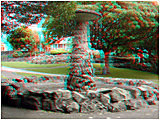|
|
|
|
|
Camera base separation of 1/30th the distance from the nearest object is common advice. This stems from purpose built 3-D film cameras having 65mm lens separation, 1/30th of the 2 metre wide screen used for polarised slide display. Film camera views overlap at approximately 2 meters wide, 2 meters away. So lens separation of 1/30th the distance from the nearest object applies for intended screen display of up to 2 metres wide. In natural vision when we gaze about, everything we choose to look at is imaged correctly in 3-D as the convergence and focus of our eyes adjust in unison to suit the subject of central attention being looked at. Objects outside of our center of converged viewing are double imaged and out of focus and are perceived with less detail. When taking a stereo photo with the camera's lenses converged to meet with the subject of interest, as with natural vision, only the area of central convergence is presented correctly. The heights of objects that are outside of the central area converged upon in the left and right views are different. Object image size on the right side of the left image is smaller than the corresponding right side of the right image, and visa versa. This is referred to as keystoning. For film projection of converged views the keystoning effect may be compensated for by converging the left and right projectors to reverse the keystone effect on screen. But this is only effective where the degree of camera convergence in the image capture was fixed and constant. Any vertical height difference in the stereo pair hinders the viewability of the 3-D image. Everything in the stereo image should be presented as viewable at the discretion of the observer. The vertical height of all points common to the left and right images must be equal, as if converged on in the original scene. |
|
Height imbalance still remains due to the difference in distance between the subject and the two lenses. Objects on the sides of an image scene are closer to one lens than to the other resulting in different image sizes. This is less apparent when objects are further from the camera. This effect also occurs with natural vision as a secondary cue for the location of objects. Another factor is that the focal length of the lenses in a stereo camera are not exactly matched. One lens will provide a slightly wider angle of view resulting in a smaller image size. Parallel imaging results in an a loss of full frame width to an aspect ratio not suitable for full screen display. Further cropping to re-establish aspect ratio reduces the image resolution. 
As parallel camera views require image height correction anyhow and result in a loss of frame width, the convergence of camera views is then preferable as it enables full frame width to be maintained. Correction of converged camera views is STUDIO 555's preferred method for still or motion stereo pair capture and for the presentation of printed, screen projected or monitor displayed 3-D images. See examples of converged height equalised 3-D images in the STUDIO 555 (ACB) 3-D ANAGLYPH GALLERY For Still and Motion Stereoscopic Photography and for Alignment of your Stereo Pairs, Contact STUDIO 555 |

|